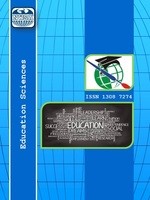ÖĞRENİM YÖNETİM SİSTEMİ PERFORMANS DEĞERLENDİRMESİ
Uzaktan Eğitim, TOPSIS, Online Eğitim, Öğrenim Yönetim Sistemi, Çok Kriterli Karar Verme,
PERFORMANCE EVALUATION OF LEARNING MANAGEMENT SYSTEM
Distance Education, Online Education, TOPSIS, Multiple-Criteria Decision Making, Learning Managment System, ,
___
- Şahin, M. ve Erişen, Y., (2010). Mesleki Ve Teknik Eğitimde Sanal Eğitim Uygulaması. e-Journal of New World Sciences Academy Education Sciences, 5(4), ss: 1825-1845.
- Terkeşli,R. ve Gül, Z., (2011). Sanal Sınıf Uygulamalarının Mesleki Gelişime Katkısının Değerlendirilmesi: Emniyet Genel Müdürlüğü Örneği. Polis Bilimleri dergisi, 13(4), ss:153-186.
- Sebetci, Ö.,(2009). Uzaktan Eğitim İçin Web Tabanlı Bir Uygulama: Sürücü Eğitimi. NWSA e-Journal of New World Sciences Academy,4(3), ss:806-814.
- Alkhateeb, F., Almaghayreh, E., Aljawarneh, S., Muhsin, Z., and Nsour, A., E-learning Tools and Technologies in Education: A Perspective, http://people.math.sfu.ca/~vjungic/ Alk.pdf, (Erişim Tarihi: 24/12/2012).
- Scanlan, C., Goyal, A., and Spagnolo, A., (2011). FacultyDriven Head-to-Head Comparison of Moodle vs. Sakai. In Proceedings of World Conference on E-Learning in Corporate, Government, Healthcare, and Higher Education, Chesapeake, VA: AACE, pp: 891-896, Costaa, C., Alvelosa, H., and Teixeira, L., (2012). The Use of Moodle e-learning Platform: A Study in a Portuguese University. Procedia Technology, 5, pp:334-343.
- Pipan, M., Arh, T., and Blazic, B.J., (2007). Evaluation and Selection of the most Applicable Learning Management System. Proceedings of the 7th WSEAS International Conference on Applied Informatics and Communications, 7, pp:350-354.
- Logan, K. and Neumann, T., (2010). Comparison of Blackboard 9.1 and Moodle 2.0. London: Learning Technologies Unit, Institute of Education, University of London. Available from URL:http://www.lkl. ac.uk/LTU/Publications.
- Stewart, B., Briton, D., Gismondi, M., Heller, B., Kennepohl, D., McGreal, R., and Nelson, C., (2012). Choosing MOODLE: An Evaluation of Learning Management Systems at Athabasca University. International Journal of Distance Education Technologies (IJDET), 5(3), pp:1-7.
- Başlangıç: 2009
- Yayıncı: E-Journal of New World Sciences Academy
ÖĞRETMEN ADAYLARININ DEMOKRATİK DEĞERLERİ VE BU DEĞERLERİN BAZI DEĞİŞKENLER AÇISINDAN İNCELENMESİ
DEMOKRATİK BİR EĞİTİM ORTAMINDA EĞİTİM PROGRAMININ ÖZELLİKLERİ
Semra TURAN, Halil AYDIN, İlker UĞULU
DİSKALKULİ YAŞAYAN ÖĞRENCİLERE İLİŞKİN ÖĞRETMEN GÖRÜŞLERİNİN DEĞERLENDİRİLMESİ
Mihriban Hacisalihoğlu KARADENİZ
SINIFTA KATILIMCI DAVRANIŞ ÖLÇEĞİNİN GELİŞTİRİLMESİ
EĞİTİM MÜFETTİŞLERİNİN HİZMET İÇİ EĞİTİM İHTİYAÇLARI
Hacı İsmail ARSLANTAŞ, Metin ÖZKAN
UYGULAMA OKULLARINDAKİ YÖNETİCİ VE EĞİTİCİ PERSONELİN OKUL DENEYİMİ DERSİNE İLİŞKİN ÖNERİLERİ
Vesile ALKAN, Selçuk ŞİMŞEK, Ali Riza ERDEM
ÖĞRENİM YÖNETİM SİSTEMİ PERFORMANS DEĞERLENDİRMESİ
